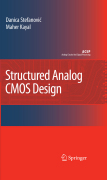
Structured Analog CMOS Design describes a structured analog design approach that makes it possible to simplify complex analog design problems and develop adesign strategy that can be used for the design of large number of analog cells. It intentionally avoids treating the analog design as a mathematical problem, developing a design procedure based on the understanding of device physicsand approximations that give insight into parameter interdependences. The proposed transistor-level design procedure is based on the EKV modeling approach and relies on the device inversion level as a fundamental design variable. Since all important design parameters can be expressed as continuous functions ofthe device inversion level, the design optimum as well as the technology limits can be easily found. All material is presented in organized and structured way The transistor-level design is based on the EKV modelling approach which leads to new way of thinking and approaching design problems The circuit-level design is given in the form of procedural design scenarios The final chapter provides the examples on the design of complex amplifiers topologies used as a part of Delta-Sigma modulator system INDICE: From the contents 1 Introduction. 2 Transistor level design. 3 BSIM to EKV conversion. 4 Basic analog structures. 5 Procedural design scenarios.6 PAD tool. 7 Topology variants. 8 Practical example: the design of analog amplifiers in the Delta-Sigma modulator system. Index.
- ISBN: 978-1-4020-8572-7
- Editorial: Springer
- Encuadernacion: Cartoné
- Páginas: 300
- Fecha Publicación: 01/07/2008
- Nº Volúmenes: 1
- Idioma: Inglés
